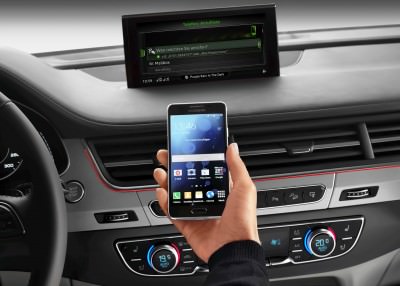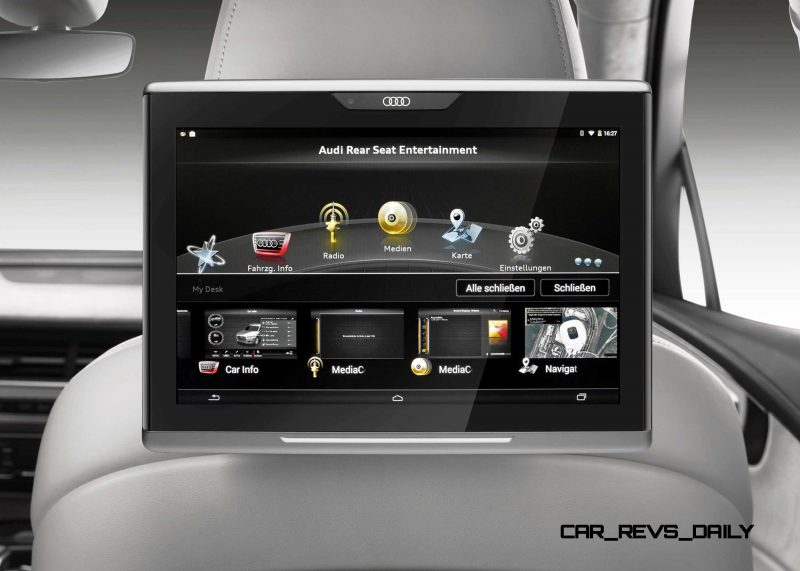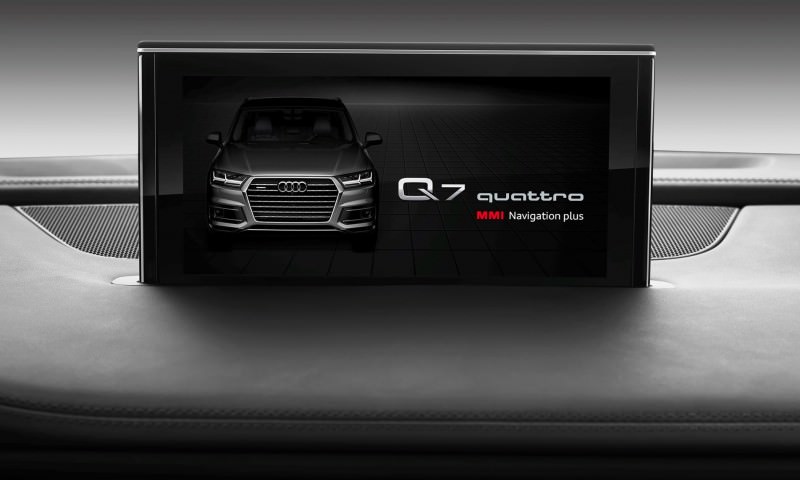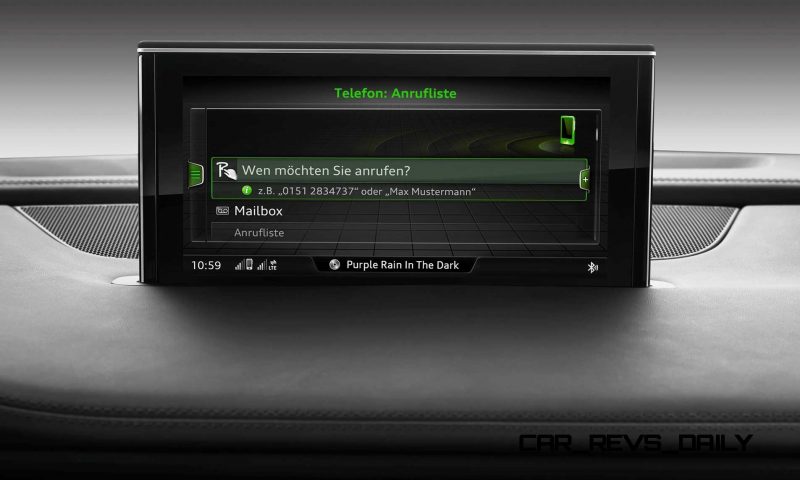 The new Audi Q7 will debut not just a much lighter chassis and all-new styling outside, but a cabin that is fresh from the carpet upward and absolutely packed with tech goodies.
The new Audi Q7 will debut not just a much lighter chassis and all-new styling outside, but a cabin that is fresh from the carpet upward and absolutely packed with tech goodies.
Where to start? The latest Virtual Cockpit design uses a 12.3-inch TFT panel in the main guage cluster, able to show 3D instruments, full Google-Earth navigation and maps, and a dozen other custom displays as needed. These are operated by voice, redundant knobs and buttons on the wheel and dash, or by the new MMI Touch control panel with multi-touch capabilities (ahead of the shifter).
On the road, the Q7’s second-generation, Nvidia-developed Modular Infotainment Matrix by Nvidia controls the central screens, dash display with a T30 processor. The 11-inch rear tablets run on a separate Tegra4 chipset — with all able to handle individual functions and displays depending on what is needed: climate, maps, online services or media playback, etc.


The online portion of the Audi Connect suite takes a huge leap into the future with a built-in 4G LTE connection for the car itself, plus a hotspot for its users’ devices.
Speaking of phone syncing and pairing, the Q7 also debuts a new chargebox system for inductive phone charging when your iPhone or Android device is wearing a special case.
In terms of syncing, the Q7 is equipped with both Apple CarPlay and Android Auto. This suite lets the new MMI screens become a second screen, showing and allowing control of most phone apps and services right from the Audi MMI screens.
It is all a bit of a mouthful to describe or take in, but these features help the Q7 vault well ahead of the Porsche Cayenne and VW Touareg in terms of cabin technology. The cruz will be how easy these features are to use — but running push updates from Audi will be able to hotfix and patch any software glitches via the built-in SIM car and 4G processors.
The Audi Connect suite for true WLAN in-car internet is sure to have a monthly fee for owners eventually, with pricing typically about $200-$300 annually projected. This might seem steep, but once accustomed to all these connected services — it will be very hard to go back.

























 Above all, this new tech helps the Q7’s cabin to feel luxurious and extremely modern. When you want to just drive and relax, the myriad tech controls will sink to black and let you relax.
Above all, this new tech helps the Q7’s cabin to feel luxurious and extremely modern. When you want to just drive and relax, the myriad tech controls will sink to black and let you relax.
We’re projecting the new Q7 to arrive stateside around July of 2015 as a 2016 model-year, with pricing from $60,000 upward. A hybrid powertrain and perhaps even a front-drive base model will be part of the product mix eventually. Standard engines will be a turbo (perhaps supercharged instead) TFSI V6 or atmospheric V8, plus a turbo-diesel six-cylinder TDI.
2016 Audi Q7 Cabin Tech
Audi connect
Most of us today aspire to be “always on” in everyday life, including in our cars. The Audi connect solutions are Audi’s response to this. Whether it is Facebook or Twitter, music streaming or an online update of the navigational map, Audi offers its customers a broad selection of cloud-based applications, all supported by ultrafast data transfer based on the LTE standard. A smartphone can be used in the familiar way. In addition, it can now open and lock the car via the Audi mobile key function.
Audi connect broadband Internet module
Audi ranks among the pioneers in the field of mobile networking. The brand began an intense cooperation with leading suppliers of hardware and software in 2005. Four years later, Audi connect in-car internet services became available. In 2010, Audi became the first manufacturer to introduce broadband internet access via an integrated UMTS (Universal Mobile Telecommunications System) module throughout its model range. In 2013, the brand presented a fully integrated LTE (Long-Term Evolution) module.
Today, the Audi connect module with broadband internet access combined with a mobile WLAN hotspot is available in many Audi models, enhancing the brand’s top-of-the-line MMI Navigation Plus and marking a great step for Audi in terms of mobile high-speed internet. The integrated WLAN hotspot allows the car’s passengers to connect as many as eight personal mobile devices.
LTE – a wireless standard five times as fast
The fully integrated LTE module supports data rates of up to 100 Mbit/s downstream, 50 Mbit/s upstream, making for very short response times and permitting exchange of large amounts of data. Passengers in the new Audi A3 can run different applications at the same time on their mobile devices.
For example, one passenger might participate in a video conference while another watches a movie. The driver, too, benefits greatly from LTE technology, such as when using Audi connect services, among them navigation based on Google Earth and Google Street View, which load extremely quickly. Full integration of LTE will permit further expansion of the Audi connect offering, starting with cloud-based music and social media all the way to car-to-X services such as wireless payments and exchange of information with traffic lights.
Audi connect in the new Audi Q7
Audi will expand the connect portfolio further in the new Q7 to be launched this year. MMI Navigation plus will come with a pre-installed LTE module.
Briefly after market launch, the Audi Q7 will offer new services beyond the current Audi connect portfolio “Audi connect Emergency Calling & Service” will become available, offering emergency calling, online calls in case of a breakdown and online booking of Audi service appointments. The “Audi connect vehicle management” package includes vehicle status report, remote locking and unlocking, park position as well as remote operation of the optional auxiliary heater. “Audi connect Emergency Calling & Service” will be free of charge for 10 years.
On the launch of this new SUV, Audi will add another gem to its Audi connect portfolio as Apple Car Play and Google Android Auto become available via the Audi smartphone interface. Audi has been in contact with Apple since early 2013 and with Google since 2014 to ensure its customers benefit quickly and widely.
Connect an iOS or Android cellular phone is connected to the USB port (iOS from version 7.1; Android from version 5.0 Lollipop) and the respective environment will open in the Audi smartphone interface. Both are tailored for use in the car. A the core of this feature is online music. This opens up the gigantic offering of Google Play Music and iTunes to Audi drivers.
In addition, both platforms offer navigation functions, missed call/appointment reminders and messaging functions. Functions can be controlled via voice, the rotary pushbutton and via the multifunction keys on the steering wheel. In the future, numerous 3rd-party applications such as Pandora, Spotify and Whatsapp will complement the offering. Audi will be demonstrating the new Audi smartphone interface at 2015 CES in an S3* concept car and other technology exhibits.
Attractive and intuitive: controls and displays in the TT and the Q7
Clear and intuitive operation has always been a strength of Audi. At CES, the brand will show the most recent advances in control and display technology as available in the new Audi TT and the upcoming Audi Q7.
One highlight is the Audi virtual cockpit. This fully‑digital combined instrument provides the driver with minutely rendered, brilliant 3D graphics of all information and offers different display modes to choose from on its 12.3‑inch TFT monitor. Audi virtual cockpit is powered by the T 30 graphics processor made by Audi’s cooperation partner NVDIA.
Audi will also present innovations in control technology The TT and the new Q7 will feature MMI terminals with an all-new interface logic. This will emulate the concept of modern smartphones, where flat hierarchies replace sprawling menu trees.
Four elements: the traditional push-turn knob, the multifunction steering wheel, natural voice operation accommodating everyday speech, and a touchpad accepting signs and multi-finger gestures, are available to control the system’s numerous functions, which include telephone, radio, media and navigation. In the Audi TT, the MMI all‑in‑touch’s interface is on the knob, while in the Audi Q7, it is a separate surface. The system provides haptic feedback after every entry.
All-round networking: Audi connect
The term Audi connect covers all applications and developments networking the car with its owner, the Internet, public infrastructure and other automobiles. This is another field of technology where Audi continually expands its lead.
A central hardware element, the Audi connect module, connects the car with the internet via LTE, the fastest available transmission standard. The car’s passengers can connect their mobile devices to a WLAN hotspot, which also provides the driver with customized online in-car services from the Audi connect portfolio. One of the innovations in this area is Online Media Streaming, which offers access to Napster and Aupeo! music services, and online updating of the navigational map.
Additional services will be available in the new Audi Q7, among them the Audi smartphone interface. Depending on whether a customer connects an iOS or an Android device, the interface will call up the Apple Car Play or Android Auto platform onto the car’s MMI monitor. At the core of the offering is an enormous selection of music titles. In addition, both platforms provide navigation and messaging functions and appointment reminders.
Future car‑to‑X technologies are another key element of Audi connect. These will enable Audi models to interact with traffic lights in a city to navigate traffic faster and more efficiently. Another solution will permit cashless payment in a parking garage or at a kerbside meter, a third one will identify speed limits and spot dangers and also relay the corresponding information to other cars.
Another innovation presented by Audi at CES is the Audi mobile key. Here, a smartphone or a smartwatch provides access to the vehicle, making them highly flexible complements to existing keys. The mobile key uses Near Field Communication (NFC), which is available even when the mobile device’s battery is empty.
Powered by NVIDIA: infotainment
At CES, Audi will be showing attractive innovations in infotainment. One of these can be seen in the Audi phone box in the new Q7, which permits easy pairing of a smartphone. It can now inductively charge compatible phones under the Qi standard.
Another first is 3D sound. In the new Audi Q7, the premium sound systems from Bose and Bang & Olufsen integrate additional speakers which open up height as a spatial dimension. A sophisticated algorithm extracts information for the third dimension from conventional stereo or 5.1 recordings and processes it for reproduction via the speaker array.
Audi to set new standards in infotainment with its Modular Infotainment Matrix and its technology network. The brand’s revolutionary approach involving a modularized electronic architecture brings Audi’s development cycles closer to those in the fast-paced consumer electronics business.
2012 saw the debut of the Modular Infotainment Matrix (MIB) with an NVIDIA T 20 chip as its heart in the Audi A3*. A mere one-and-a-half years later, the MIB’s second stage has been deployed in the Audi TT and in the new Audi A6* and A7 Sportback*. Again, an NVIDIA processor plays a key role. The T 30 is a quad-core chip running a 3D graphic program from specialist software manufacturer. Rightward to render brilliant graphics on two displays simultaneously. Thanks to the matrix’ modular structure, Audi can keep it continuously up-to-date and quickly integrate attractive innovations from consumer electronics.
Another chip from NVIDIA, the Tegra 4, powers the Audi tablet debuting in the new Q7. With an active 10.1‑inch display, the Audi tablet’s will provide mobile rear-seat entertainment. In the car, the tablet will connect itself to the on-board infotainment and navigation system via WLAN. What is special about the Audi tablet is that it has been expressly designed for use in the car. This means it is both high-class and robust. Of course, it can also be used on a WLAN outside the car.
Audi as driving force: electronic architecture
To expand its lead in hardware, Audi set up the Progressive Semi Conductor Program (PSCP) in late 2010. Under the program, Audi directly involves not just its system suppliers but also semiconductor makers. It is a key factor for future innovations.
As in hardware, so Audi develops solutions of its own in software – a task falling mainly to e.solutions GmbH, a subsidiary.
In vehicle electrics, Audi has developed a new, scalable architecture, the 48 volt onboard partial network. It will soon complement conventional 12 volt networks and permit deployment of new high-performance electric components. These will include an electric compressor as a supplementary turbocharger or an extra-strong generator capable of recuperating a higher amount of kinetic energy and, when used as a motor, transforming the car’s powertrain into an efficient mild hybrid.
Future power: electromobility – charging without a cable
Under the name e‑tron, Audi resolutely advances the electrification of the powertrain. One of many aspects in this is contactless charging of all- or part-electric e‑tron models. Audi is putting great effort into induction-based supply of energy, known as Audi wireless charging (AWC).
The brand has developed a power matrix offering numerous options so as to provide each customer with a solution filling his or her precise needs. Approaches range from a 48‑volt onboard network to plug-in hybrid powertrains. These marry the advantages of a combustion engine with those of electric traction, providing the customer with long range, power and efficiency all at the same time.
The launch of the A3 Sportback e‑tron* in 2014 was Audi’s successful entrance into plug‑in hybrid technology. This will now be swiftly rolled out across the model range, with the medium and top segment next in line. A new e‑tron model is set for introduction every year. At the same time, Audi is working on purely-electric vehicles with high-capacity batteries and powerful motors requiring no compromises in terms of range and usability.
NEXT PAGE

Tom Burkart is the founder and managing editor of Car-Revs-Daily.com, an innovative and rapidly-expanding automotive news magazine.
He holds a Journalism JBA degree from the University of Wisconsin – Madison. Tom currently resides in Charleston, South Carolina with his two amazing dogs, Drake and Tank.
Mr. Burkart is available for all questions and concerns by email Tom(at)car-revs-daily.com.














































